Cats were represented in social and religious practices of ancient Egypt for more than 3,000 years. Several ancient Egyptian deities were depicted and sculptured with cat-like heads such as Mafdet, Bastet and Sekhmet, representing justice, fertility, and power, respectively. The deity Mut was also depicted as a cat and in the company of a cat.

Nakht was an ancient Egyptian official who held the position of a scribe and astronomer of Amun, probably during the reign of Thutmose IV of the Eighteenth Dynasty. He was buried in the Theban Necropolis in tomb TT52.
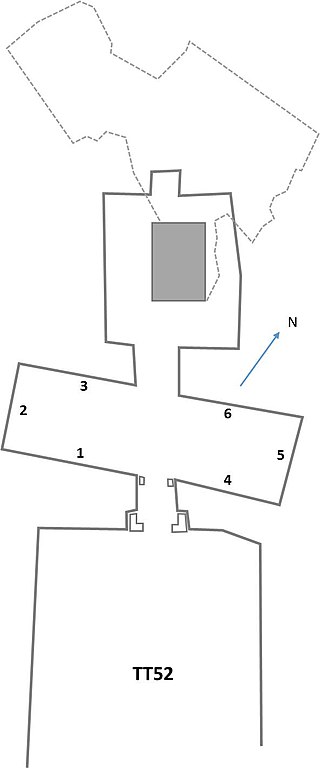
The Theban Tomb TT52 is located in Sheikh Abd el-Qurna, part of the Theban Necropolis, on the west bank of the Nile, opposite to Luxor. It is the burial place of Nakht, an ancient Egyptian official who held the position of a scribe and astronomer of Amun, probably during the reign of Thutmose IV during the Eighteenth Dynasty, the first dynasty of the New Kingdom.

The Tomb of Two Brothers is an ancient sepulchre in Deir Rifeh, Egypt. It contains the chamber tomb of the ancient Egyptian high status priests Nakht-Ankh and Khnum-Nakht, which dates from the 12th Dynasty.

The Theban Tomb TT359 is located in Deir el-Medina, part of the Theban Necropolis, on the west bank of the Nile, opposite to Luxor. It is the burial place of the ancient Egyptian workman Inherkhau, who was Foreman of the Lord of the Two Lands in the Place of Truth during the reigns of Ramesses III and Ramesses IV. He also owned Tomb TT299. Inherkau was the son of the similarly titled Foreman Huy. Inherkau's wife was named Wab.

A necropolis is a large, designed cemetery with elaborate tomb monuments. The name stems from the Ancient Greek νεκρόπολις nekropolis, literally meaning "city of the dead".

The Theban Tomb TT18 is located in Dra' Abu el-Naga', part of the Theban Necropolis, on the west bank of the Nile, opposite to Luxor. It is the burial place of the ancient Egyptian Baki, who was Chief Weigher of the Gold of Amun during the early Eighteenth Dynasty.
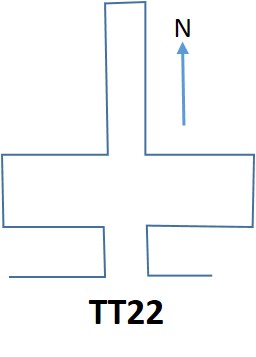
The Theban Tomb TT22 is located in Sheikh Abd el-Qurna, part of the Theban Necropolis, on the west bank of the Nile, opposite to Luxor. It is the burial place of the ancient Egyptian Wah, who was royal butler during the early Eighteenth Dynasty.
The Theban Tomb TT170 is located in Sheikh Abd el-Qurna, part of the Theban Necropolis, on the west bank of the Nile, opposite to Luxor. It is the burial place of the ancient Egyptian Nebmehyt, who was a scribe of recruits of the Ramesseum in the Estate of Amun during the reign of Ramesses II in the Nineteenth Dynasty.

The Theban Tomb TT171 is located in Sheikh Abd el-Qurna, part of the Theban Necropolis, on the west bank of the Nile, opposite to Luxor. The name of the owner is not known. His wife was named Isis (Aset) according to an inscription on the facade. The tomb dates to the Eighteenth Dynasty of Egypt.
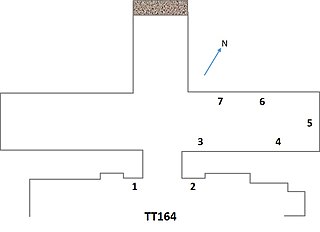
The Theban Tomb TT164 is located in Dra' Abu el-Naga', part of the Theban Necropolis, on the west bank of the Nile, opposite to Luxor.
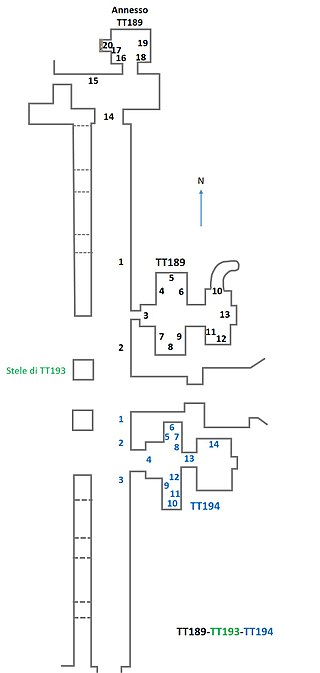
Tomb TT189 is located in the necropolis of El-Assasif in Thebes, Egypt. It contains the sepulchre of Nakhtdjehuty, who was an overseer of the carpenters of the northern lake of the god Amun and the head of the goldworkers in the Estate of Amun during the 19th Dynasty reign of Ramesses II. Nakhtdjehuty's tomb is part of the TT192 tomb complex.
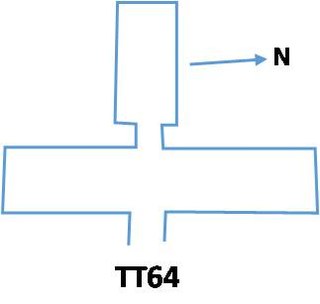
The Theban Tomb TT64 is located in Sheikh Abd el-Qurna. It forms part of the Theban Necropolis, situated on the west bank of the Nile opposite Luxor. The tomb is the burial place of the ancient Egyptian Hekerneheh, who was a King's Tutor of Prince Amenhotep during the reign of Tuthmosis IV and lived into the reign of Amenhotep III in the Eighteenth Dynasty.

The Theban Tomb TT282 is located in Dra' Abu el-Naga', part of the Theban Necropolis, on the west bank of the Nile, opposite to Luxor. It is the burial place of the ancient Egyptian Nakhtmin, also called Nakht, who lived during the reign of Ramesses II of the 19th Dynasty.

The Theban Tomb TT385 is located in Sheikh Abd el-Qurna, part of the Theban Necropolis, on the west bank of the Nile, opposite Luxor. It is the burial place of the ancient Egyptian Hunefer (Haunefer), who was a Mayor of the Southern City (Thebes) during the reign of Ramesses II in the Nineteenth Dynasty.

The Theban Tomb TT383 is located in Qurnet Murai, part of the Theban Necropolis, on the west bank of the Nile, opposite to Luxor. It is the burial place of the ancient Egyptian Viceroy of Kush named Merymose, who lived during the 18th Dynasty and served under Amenhotep III.
The Theban Tomb C.14 is an ancient Egyptian tomb in Thebes, Upper Egypt. It is located in Sheikh Abd el-Qurna, part of the Theban Necropolis on the west bank of the Nile opposite Luxor. The tomb likely dates to the Twenty-sixth Dynasty of Egypt.
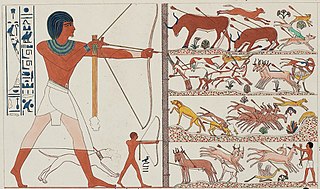
Tomb A.5 is the modern number given to a now lost Theban tomb in Dra' Abu el-Naga'. The burial dates to the Ancient Egyptian 18th Dynasty and belonged to the overseer of the granary of the Lord of the Two Lands, Neferhotep. The tomb was visited by the French traveller Frédéric Cailliaud, who copied and published several scenes. Evidently, he saw the tomb in a fairly good condition and was described by others as superb. The location of the tomb got lost within the Nineteenth century. According to the old drawings published., there are several scenes depicted in the tomb. These include both hunting in the marshes and hunting in the desert, a banquet, and scenes showing vintage and agriculture.














